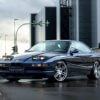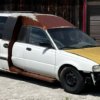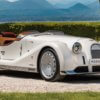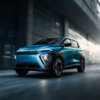What did we know about small roadsters with classic layouts before 1999? They are cheerful, nimble and can give a sea of emotions almost every day in a favorable climate. And then he came… An atmospheric “four” with extremely high boost, a double wishbone suspension, ideal weight distribution and a driving character that usually makes people scream out loud. This is the S2000, one of the best Honda cars and one of the most outstanding not only among Japanese ones. He is a quarter of a century old, but he is forever young and crazy!
As often happens, it all started with a concept: the experimental SSM (Sport Study Model) debuted at the 1995 Tokyo Motor Show. Obviously, its creators were not allowed to sleep peacefully with thoughts about the promising successor to the classic Honda S800. The baby from the sixties and the show car were united by an idea and essence, although, of course, they were at opposite poles of evolution.
Early Honda S800s featured a chain-driven drive axle and independent rear suspension. After modernization, the sophistication was replaced by a traditional driveshaft and axle beam with a Panhard rod. This is the opposite upgrade.
Honda  Honda
Honda  Honda
Honda
The designers also drew creativity from the 1963 RA270 formula prototype and the iconic Caterham Seven. Hence the result – a spectacular two-seater with a design from Pininfarina, an aluminum body and a two-liter “five” paired with a five-speed automatic transmission. By the way, the “odd” engine was not alien to Honda – the G line of 2.0 and 2.5 liters (one camshaft, four valves per cylinder) was installed on the domestic Japanese Vigor, Inspire, Saber, Ascot and Rafaga.
 Honda SSM
Honda SSM
Honda  Honda SSM
Honda SSM
Honda  Honda SSM
Honda SSM
Honda
The roadster seemed too good to be promoted to production. A cynical and mocking tease. But this is a Honda! Its advertising slogan is “The Power of Dreams.” The main thing is to dream, and everything will happen. By the end of the decade, when many had forgotten about the Sport Study Model, the company introduced the commercial S2000 based on it. Mercedes-Benz SLK and BMW Z3 were sad, Mazda MX-5 tensed. And petrolheads all over the world rejoiced at their next idol.
 Honda City Turbo
Honda City Turbo
Honda  Honda City Turbo
Honda City Turbo
Honda  Honda City Turbo
Honda City Turbo
Honda
A small lyrical digression. Now Honda, like the lion’s share of manufacturers, builds models with turbo engines. This is the everyday need to meet environmental requirements and the natural desire to taste the fruits of progress. Decades of triumph of atmospheric superengines are in the past. It should be noted: far from timid flirtations with supercharging date back to time immemorial. Let’s take a moment to look at the mild hot box 1982-1986 City Turbo. Hirotoshi, the son of the founder Soichiro Honda, conceived it with a 1.2-liter turbo-four with output up to 110 hp. For the range of that time, this was a trial run and an exception to the rule, because it confidently went in a completely different direction.
 Legendary Integra Type R (DC2): 1.8-liter naturally aspirated B18C engine, 200 hp. and maximum 8900 rpm
Legendary Integra Type R (DC2): 1.8-liter naturally aspirated B18C engine, 200 hp. and maximum 8900 rpm
Honda  Legendary Integra Type R (DC2): 1.8-liter naturally aspirated B18C engine, 200 hp. and maximum 8900 rpm
Legendary Integra Type R (DC2): 1.8-liter naturally aspirated B18C engine, 200 hp. and maximum 8900 rpm
Honda
The brand reputation was forged by such extraordinary cars with high-speed “thresher” as the Civic Type R, Integra Type R and, of course, the mid-engined NSX, an example of perfectionism. All of them fit harmoniously into the context of celebrating the 25th anniversary of the S2000. At the time of his birth, Honda had a very distinctive image. All that remained was to offer the icing on the cake. But you know, the new product greatly surprised even the fans of the brand who were ready for anything!
 S2000 was produced from 1999 to 2009
S2000 was produced from 1999 to 2009
Honda
“Two thousandth” is an ode to brevity and grace. Aging gracefully and worthy of being considered a living classic. However, it is still very far from vegetating in museums. Movement is life! An uncompromising sports car fits a person like a glove, controls the central nervous system, breathing and heartbeat, captures thoughts, and completely subjugates it. It is not surprising that the team of engineers who created it was led by a genius – Shigeru Uehara. He joined the R&D department in 1971 and became an expert in handling tuning. The real gems in Shigeru-san’s portfolio are the spartan lightweight NSX-R, the Integra Type R (DC2/DC5) and, of course, the S2000.
 Shigeru Uehara: “You will be surprised to know that we had very little input from marketers. This was a deliberate move as we wanted to make something that would please us as a team of engineers rather than trying to please everyone. If you listen to everyone and include everything they ask, then all the cars are the same in the end. We wanted a more focused car.”
Shigeru Uehara: “You will be surprised to know that we had very little input from marketers. This was a deliberate move as we wanted to make something that would please us as a team of engineers rather than trying to please everyone. If you listen to everyone and include everything they ask, then all the cars are the same in the end. We wanted a more focused car.”
Honda
Take a look at the anatomy of the S2000. The weak point of many convertibles and roadsters is insufficient body rigidity. Honda tried to correct this shortcoming with a “skeleton” with a powerful tunnel as the basis of the structure. The front and back of the central structure and sidewalls are connected by X-shaped braces. They are directly attached to the subframes. Both axles have double wishbone suspension. The steering mechanism uses electric power steering for reasons of compactness and simplicity.
 Honda
Honda
Such a promising driver’s chassis required a decent engine. And here Honda not only outdid itself, but made the whole world gasp.
A two-liter “juice pack” labeled F20C is a punishing sword of justice on the heads of everyone who has ever looked at the modest displacement with arrogance and contempt. It develops 240 hp. naturally aspirated. Or, in other words, a record 120 hp. per liter For their loved ones, the Japanese built an even cooler 250-horsepower version. The “twist” is no less impressive. Peak output is available at 8300 rpm, maximum torque of 207 Nm is available at 7500 rpm, and the cut-off occurs at the magical 9000 rpm. Among the features are forged pistons and a VTEC variable valve timing system, which gives the “explosion” characteristic of older Honda engines at high speeds.
 Honda
Honda
According to factory data, the S2000 will launch from 0 to 97 km/h (60 mph) in less than six seconds. The obviously hesitant guys from the American magazine Car and Driver got as much as 6.8 seconds. In any case, the roadster drives cheerfully, although sprints from traffic lights are too banal entertainment. His domain is racing tracks. It is here that the platform with the F20C shifted to the limits of the wheelbase is revealed in all its glory.
 Honda
Honda  Honda
Honda
Car and Driver’s testers were delighted: “The chassis setup is almost flawless, with weight distribution adjusted to a perfect 50/50. The car conveys a clear picture of what’s happening in the tire contact patch, and like most Hondas, we can use every last ounce of 0.90 g of lateral g with full confidence. The S2000 corners confidently but never feels stuck in one position. The ride is firm, but not rough. The rear of the body grips the asphalt well, even too well. We could only throw it off balance by pressing the accelerator pedal mid-corner. The lack of playfulness in the stern is perhaps the only drawback of the S2000; we prefer sports cars that help with handling in this way.”
 Honda
Honda
For the 2004 model year, the roadster was updated. The working volume has increased to 2.2 liters in order to slightly smooth out the evil impulsive nature. The horsepower is the same, but the elasticity is improved. Torque reached 220 Nm and shifted down to 6500 rpm. For civilian use this is a blessing, but emotions have obviously diminished – the cut-off has been shifted to 8200 rpm. Plus, the gear ratios in the non-alternative six-speed manual transmission have been adjusted, and the suspension settings have been changed (the front springs are 6.7% stiffer, the rear springs are 10% softer). Body rigidity has been increased. Redesigned door trims and the center console made it possible to gain a couple of tens of centimeters in the shoulder area. And here’s what’s funny: according to Car and Driver measurements, acceleration was reduced to 5.4 seconds. Magic! Or did the testers just not find a common language with the car last time?…
 Honda
Honda  Honda
Honda  Honda
Honda
The irrepressible Shigeru-san did not sit idle for long. In 2008, an intelligent, thin Japanese man stood under the gun of an Edmunds camera and talked about the extreme S2000 CR (Club Racer). The essence is reflected in the name: the owner must drive the “si-ar” to the track under his own power, have a good time in the turns and go home on it.
 Only 699 examples of the S2000 Club Racer were made for the American market. Meanwhile, JDM enthusiasts were pleased with the Type S modification with similar nuances. 1,755 built.
Only 699 examples of the S2000 Club Racer were made for the American market. Meanwhile, JDM enthusiasts were pleased with the Type S modification with similar nuances. 1,755 built.
Honda
Power? Alas, no change. But the springs and shock absorbers are stiffer and the anti-roll bars are thicker. There is a brace behind the seats in the luggage compartment, the steering gear ratio is “shorter” (13.8:1 versus 14.9:1 for the original roadster), and a sports muffler screams at the exhaust. Tires are Bridgestone Potenza RE070 215/45R17 front and 255/40R17 rear. To reduce weight, we had to abandon the folding fabric top (it is replaced by an aluminum roof), audio system and air conditioning (optional), sound insulation, jack and spare wheel.
 S2000 Club Racer
S2000 Club Racer
Honda  S2000 Club Racer
S2000 Club Racer
Honda
Here’s what Car and Driver wrote about the club racer: “First of all, this faster S2000 doesn’t go any faster. In fact, it’s a little slower, hitting 60 mph in 5.7 seconds and hitting the quarter mile in 14.4 seconds, versus 5.5 and 14.0 seconds for the last S2000 we tested. The CR is slightly lighter than the standard car, but like Honda’s other sporty versions, it doesn’t get any extra power. The potential of the 2.2-liter four-cylinder engine is almost exhausted. Also, the aerodynamic drag with the front spoiler and large wing is not a plus for sprints.
 Honda
Honda
On the other hand, the defining feature of the CR’s handling, given the fast laps at Grattan Raceway Park in western Michigan, seems to be relentless understeer. To be honest, she inspires confidence. Corners are much easier to attack when you’re confident the rear end will stay behind you. Stubborn resistance when entering a corner is not an advantage for a fast lap. But the Bridgestone Potenza RE070 tires have the acumen of an insurance salesman, delivering 0.95 g of lateral load versus the regular S2000’s 0.88 g, which is reassuring in high-speed corners. Cornering also forces the wing and front spoiler to work. These are functional aerodynamic elements, not just cosmetic additions.”
As a sports car, the “two thousandth” is one hundred percent rich. This is indirectly confirmed by numerous motorsport victories. For example, triumph in the Japanese Super Taikyu Series championship (class ST-4) and the 24-hour marathon at the Nurburgring in its class. Interestingly, of the 113,889 copies produced, more than half were in the USA and Canada. The historical homeland and Europe were content with the remnants. Do you have a Honda S2000 in your garage? Take care of her! Such honest, original and, sorry for the cliché, “real” cars, most likely, will no longer exist. /m
Type-R Celebration: hundreds of “charged” Hondas were collected from all over Japan Seven Samurai: which Japanese cars need to be returned to service Little-known Honda models that everyone has forgotten about







